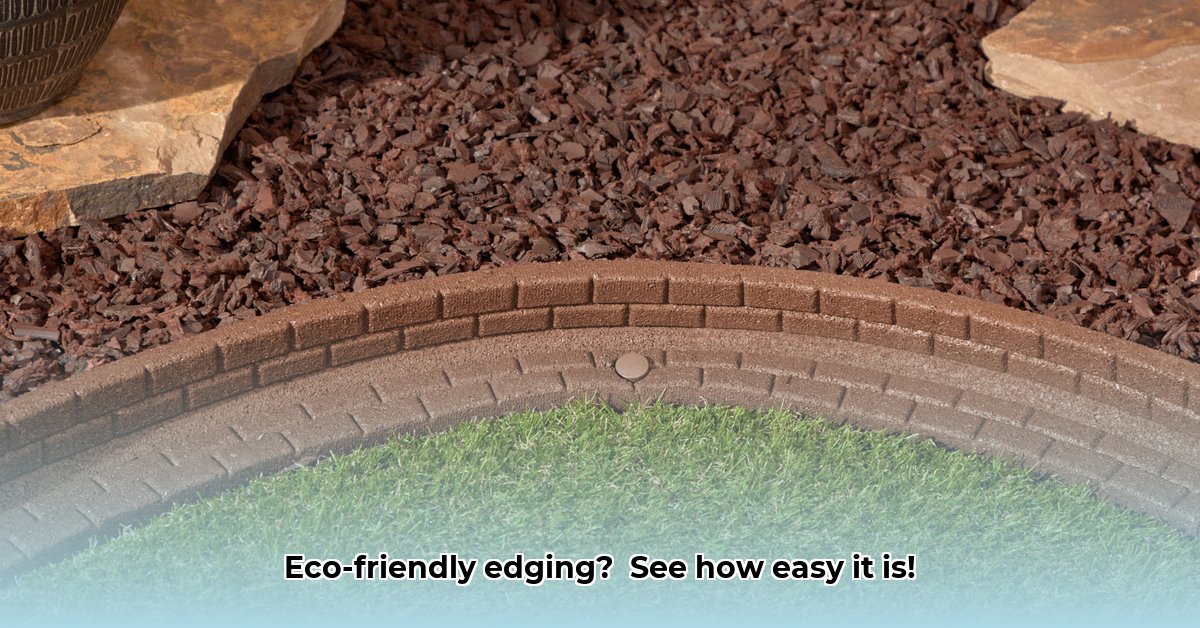Tired of landscape edging that doesn’t last? Rubberific edging could be the sustainable solution you need. This guide explores its installation, maintenance, and environmental impact. For more sustainable paving options, check out these rubber pavers. Get ready for a beautiful and eco-conscious landscape design!
Rubberific Landscape Edging: An Eco-Friendly Option
Rubberific landscape edging aims to provide a greener option for defining garden beds and paths. It is made from recycled rubber, promising durability and simple upkeep. Let’s examine its qualities more closely, using research-based insight.
Material Composition and Environmental Impact
The appealing feature of Rubberific edging is its use of recycled rubber. Compared to new plastic or concrete edging, this is a step in a positive direction. To accurately assess its environmental effect, we need more details from the manufacturer regarding their processes, sourcing, and ideally, a comprehensive lifecycle assessment.
A lifecycle assessment (LCA) would compare Rubberific’s environmental footprint to similar materials. An LCA examines all aspects, including sourcing, manufacturing, transport, usage, and disposal. This creates a picture of the complete impact. Without this research, evaluations of Rubberific’s eco-friendliness remain estimations, highlighting the need for supply chain clarity and insights into the production process.
The U.S. Environmental Protection Agency (EPA) supports responsible management of scrap tires, encouraging beneficial uses like landscape edging. Some experts also suggest considering the prospect of chemical leaching from the rubber over time, potentially affecting soil and nearby plants. While not a guaranteed problem, it’s worth considering, especially if you’re growing edible plants, or have children or pets. Continuous research will aid in better understanding these long-term implications.
Installing Your Rubberific Edging: A Comprehensive Guide
Installing Rubberific edging is generally straightforward. Here’s a detailed guide to help:
Step 1: Planning and Measuring: Before you start, measure the perimeter where you will install the edging. Sketch the design, considering curves and corners. Account for any overlaps or connection points between edging sections.
Step 2: Site Preparation: Remove existing edging, weeds, rocks, and debris. Loosen the soil along the installation line using a garden spade or tiller. For compacted soil, consider using a cultivating tool to break it up further. This simplifies burying the edging and ensures a secure fit.
Step 3: Edging Placement: Position the Rubberific edging pieces along the planned line. Use landscaping stakes or pins to hold them in place while you connect the sections. Maintain a consistent depth and ensure the top edge is level.
Step 4: Securing the Edging: Join the Rubberific edging sections based on the manufacturer’s guidelines, usually by pushing them together or using interlocking mechanisms. Ensure a tight fit to prevent gaps. If using stakes, drive them in at an angle for better stability.
Step 5: Finishing Touches: Add soil or mulch behind the edging for a neat and finished appearance. This stabilizes the edging and provides a professional finish. Consider adding a layer of landscape fabric behind the edging to prevent weed growth.
Troubleshooting Tips: For curves or uneven ground, cut the edging using a utility knife or hand saw (follow the manufacturer’s cutting advice). For tight curves, make small, incremental cuts to allow the edging to bend more easily. Ensure proper drainage behind the edging, especially in areas prone to water accumulation. Adding gravel can help.
Maintenance and Long-Term Durability
Rubberific edging is marketed as exceptionally durable, resisting cracking, rotting, and freeze damage. While it likely holds up well, independent, long-term testing is needed to confirm its endurance under various conditions. How does its longevity compare to traditional edging materials like wood or metal?
Fortunately, maintaining Rubberific edging is simple. Regular cleaning helps it look its best. Proper installation also extends its lifespan. To clean, simply hose down the edging or use a mild soap and water solution for tougher stains.
Weighing the Pros and Cons
Here’s a balanced examination of the advantages and disadvantages of using Rubberific landscape edging:
| Advantages | Disadvantages |
|---|---|
| Durable and long-lasting (potentially) | Lack of full transparency regarding sourcing |
| Relatively easy DIY installation | Potential for chemical leaching (requires more study) |
| Eco-friendly (made from recycled materials) | Long-term durability needs further verification |
| Attractive appearance | Cost compared to other materials |
| Low maintenance | May have limited availability in some areas |
| Resists cracking, rotting, and freeze damage | Limited color options compared to other materials |
Comparing Rubberific to the Competition
Before deciding, compare Rubberific with alternatives like bamboo, reclaimed wood, metal, or recycled plastic. Each option offers different benefits regarding cost, installation ease, longevity, and environmental impact. Researching these choices helps align your decision with your needs and values.
The Bottom Line: Informed Choices for a Greener Garden
Rubberific landscape edging represents a step toward sustainable landscaping, but further environmental impact information is necessary. As consumers, it’s important to demand greater transparency from manufacturers, encouraging responsible purchasing. The product’s overall long-term effects can be determined by weighing the information, considering drawbacks, and comparing it with other options. This helps you make an informed decision that matches your commitment to environmental responsibility and your landscaping project. Further research will improve knowledge of the product’s effects.
How to Compare Recycled Rubber Landscape Edging to Other Eco-Friendly Options
Key Takeaways:
- Recycled rubber’s weather resistance makes it durable compared to plastic.
- It allows for easy installation, typically with minimal digging needed.
- Its recycled material reduces landfill waste, offering an environmentally friendly option.
- Long-term degradation and root growth impact require more investigation.
- A cost comparison against eco-friendly options should be performed for informed decision-making.
Material Properties and Environmental Impact
Recycled rubber edging boasts a texture from shredded tires, providing durability and weather resistance that exceeds some plastic options. When compared to other eco-friendly options, its life cycle is essential to consider.
Other sustainable materials to consider include bamboo, reclaimed wood, or even living edging using plants. These materials may have different maintenance requirements than rubber and different levels of resilience.
Recycled rubber’s reduction in landfill waste is environmentally beneficial. However, concerns about potential chemical leaching and the need for a comprehensive life cycle assessment call for more research. Manufacturers should strive for transparency by providing detailed information about their sourcing and manufacturing processes.
Installation: A Step-by-Step Installation Guide
Installing rubber edging is often straightforward, with less digging required. Here’s how:
- Measure and Plan: Determine the total length required and plan the edging route, considering any curves or corners.
- Prepare the Ground: Level the area and remove any rocks, roots, or debris. Ensure the soil is compact enough to hold the edging in place.
- Cut to Size (if needed): Flexible rubber edging might need cutting to fit specific areas or create curves. Use a utility knife or saw.
- Place the Edging: Position the edging along the planned line, ensuring it’s flush with the ground.
- Secure with Stakes: Use landscaping stakes at regular intervals for support. Drive the stakes into the ground at an angle for better stability.
Maintenance and Durability
Rubber edging requires periodic cleaning and is estimated to offer years of service. However, balancing possible degradation and future replacement is important. Regular cleaning with water and a brush removes dirt and debris. Inspect the edging periodically for any signs of damage or wear.
Comparing Recycled Rubber to Other Options: A Practical Analysis
We’ll use a table to compare recycled rubber to other eco-friendly options.
| Feature | Recycled Rubber | Reclaimed Wood | Bamboo | Living Edging (e.g., Lavender) |
|---|---|---|---|---|
| Durability | High | Moderate | Moderate | Low to Moderate |
| Installation | Easy, minimal digging | Moderate | Moderate | Easy (planting required) |
| Maintenance | Low | Moderate to High | Moderate to High | Moderate to High |
| Environmental Impact | Generally Positive; needs more data | Varies (source and treatment) | Varies (source and treatment) | Positive (biodiversity benefits) |
| Cost | Moderate | Moderate to High | Moderate to High | Low to Moderate |
The best option depends on your needs. Some value low maintenance, and others prioritize aesthetics or cost.
1Family Handyman
Addressing Potential Drawbacks
While recycled rubber edging offers many advantages, it is essential to acknowledge its limitations. Root penetration may be an issue for some plants, and long-term environmental impact requires more study. Source materials from reputable manufacturers who prioritize ethical sourcing and sustainability practices. Look for certifications or labels that indicate the recycled content and manufacturing standards.
Rubberific Edging for Sloped Landscapes: Installation Techniques and Considerations
Key Takeaways:
- Rubberific edging lasts 15-20 years, longer than plastic, potentially saving costs over time.
- Installation is DIY-friendly, but slopes present challenges.
- Its recycled composition supports environmentally conscious landscaping. However, the manufacturer must offer full transparency regarding sourcing and environmental impact.
- Rubberific edging
- Kitchen tiling wall: Elevate your kitchen with stylish wall tiles - December 16, 2025
- Gray Kitchen Backsplash Tile: Ideas for a Stylish Upgrade - December 14, 2025
- Backsplash For Gray Cabinets: Choosing the Right Backsplash Style - December 13, 2025









